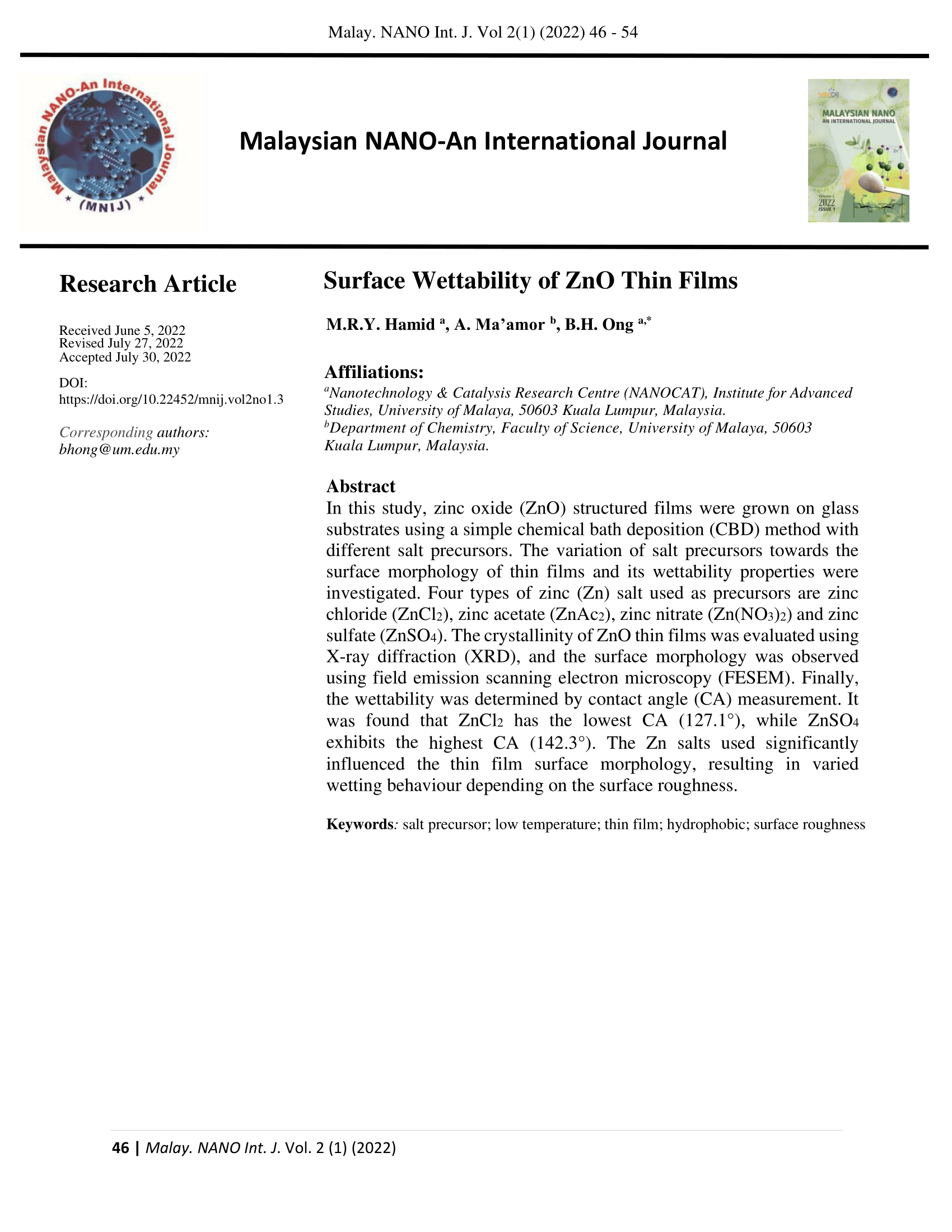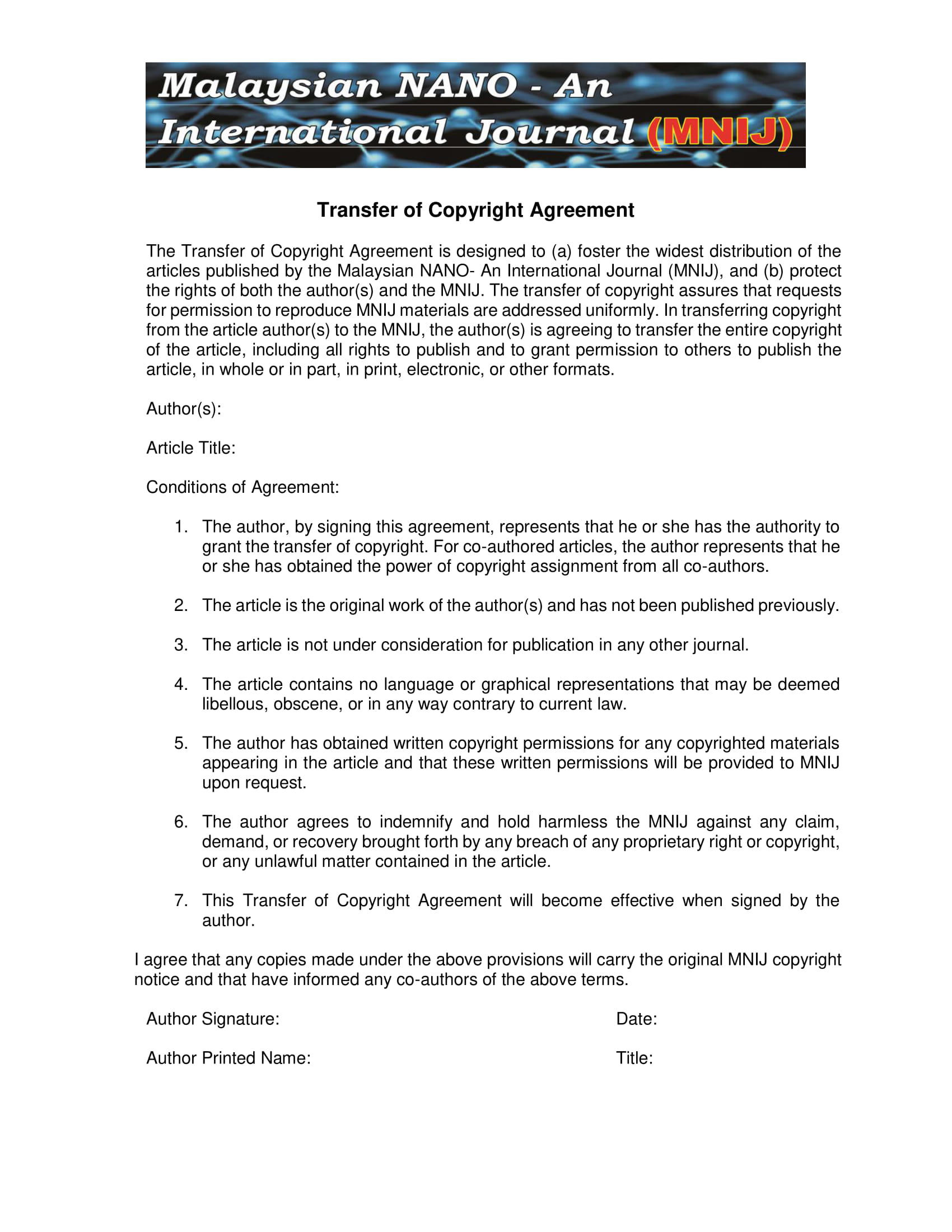Surface Wettability of ZnO Thin Films
DOI:
https://doi.org/10.22452/mnij.vol2no1.3Keywords:
surface coatings, chemical synthesis, salt precursor, low temperature, hydrophobic, surface roughnessAbstract
In this study, zinc oxide (ZnO) structured films were grown on glass substrates using a simple chemical bath deposition (CBD) method with different salt precursors. The variation of salt precursors towards the surface morphology of thin films and its wettability properties were investigated. Four types of zinc (Zn) salt used as precursors are zinc chloride (ZnCl2), zinc acetate (ZnAc2), zinc nitrate (Zn(NO3)2) and zinc sulfate (ZnSO4). The crystallinity of ZnO thin films was evaluated using X-ray diffraction (XRD), and the surface morphology was observed using field emission scanning electron microscopy (FESEM). Finally, the wettability was determined by contact angle (CA) measurement. It was found that ZnCl2 has the lowest CA (127.1°), while ZnSO4 exhibits the highest CA (142.3°). The Zn salts used significantly influenced the thin film surface morphology, resulting in varied wetting behaviour depending on the surface roughness.
Downloads
References
F. Rahman, Zinc oxide light-emitting diodes: A review. Optical Engineering. 2019; 58: 010901- 010921.
M. Laurenti, V. Cauda, R. Gazia, M. Fontana, V.F. Rivera, S. Bianco, G. Canavese, Wettability control on ZnO nanowires driven by seed layer properties. Eur. J. Inorg. Chem. 2013; 14: 2520- 2527.
V. Khranovskyy, T. Ekblad, R. Yakimova, L. Hultman, Surface morphology effects on the light- controlled wettability of ZnO nanostructures. Applied Surface Science. 2012; 258: 8146– 8152.
P. Yang, K. Wang, Z. Liang, W. Mai, C.-X. Wang, W. Xie, P. Liu, L. Zhang, X. Cai, S. Tan, J. Song, Enhanced wettability performance of ultrathin ZnO nanotubes by coupling morphology and size effects. Nanoscale. 2012; 4: 5755-5760.
S. Shankar, J.-W. Rhim, Effect of Zn salts and hydrolyzing agents on the morphology and antibacterial activity of zinc oxide nanoparticles. Environmental Chemistry Letters. 2019; 17: 1105– 1109.
C.-H. Chao, P.-W. Chi, D.-H. Wei, Investigations on the crystallographic orientation induced surface morphology evolution of ZnO thin films and their wettability and conductivity. The Journal of Physical Chemistry C. 2016; 120: 8210-8219.
H. Ennaceri, L. Wang, D. Erfurt, W. Riedel, G. Mangalgiri, A. Khaldoun, A.E. Kenz, A. Benyoussef, A. Ennaoui, Water-resistant surfaces using zinc oxide structured nanorod arrays with switchable wetting property. Surface & Coatings Technology. 2016; 299: 169-176.
S. Duo, R. Zhong, Z. Liu, J. Wang, T. Liu, C. Huang, H. Wu, One-step hydrothermal synthesis of ZnO microflowers and their composition-/hollow nanorod-dependent wettability and photocatalytic property. Journal of Physics and Chemistry of Solids. 2018; 120: 20-33.
B.-J. Lia, Li.-J. Huang, M. Zhou, N.-F. Ren, Morphology and wettability of ZnO nanostructures prepared by hydrothermal method on various buffer layers. Applied Surface Science. 2013; 286: 391- 396.
M. Shaban, M. Zayed, H. Hamdy, Nanostructured ZnO thin films for self-cleaning applications. RSC Advances. 2017; 7: 617-631
T. Huhtamäki, X. Tian, J.T. Korhonen, R.H.A. Ras, Surface-wetting characterization using contact-angle measurements. Nature Protocols. 2018; 13: 1521-1538.
T. Rezayi, M.H. Entezari, Wettability properties vary with different morphologies of ZnO nanoparticles deposited on glass and modified by stearic acid. New Journal of Chemistry. 2016; 40: 2582-2591.
H. Ghannam, A. Chahboun, M. Turmine, Wettability of zinc oxide nanorod surfaces. RSC Advances. 2019; 9: 38289-38297.
M.R.Y. Hamid, S.B.A. Hamid, B.H. Ong, The Effects of deposition time and seed layer on morphological properties of zinc oxide by chemical bath deposition. Solid State Phenomena. 2017; 264: 240-243.
A.D. Prasetya, M. Rifai, Mujamilah, H. Miyamoto, X-ray diffraction (XRD) profile analysis of pure ECAP-annealing Nickel samples, Journal of Physics: Conference Series. 2020; 1436: 012113
P.S. Emani, H.A. Maddah, A. Rangoonwala, S. Che, A. Prajapati, M.R. Singh, D.M. Gruen, V. Berry, S.K. Behura. Organophilicity of graphene oxide for enhanced wettability of ZnO nanorods. ACS Applied Materials & Interfaces. 2020; 12: 39772−39780.
R. Mardosaitė, A. Jurkevičiu̅ tė, S. Račkauskas, Superhydrophobic ZnO nanowires: Wettability mechanisms and functional applications. Cryst. Growth Des. 2021; 21: 4765-4779.

Downloads
Published
How to Cite
Issue
Section
License





